Take Better Fish Selfies
Take photos of your catch that are easier on both you and the fish.
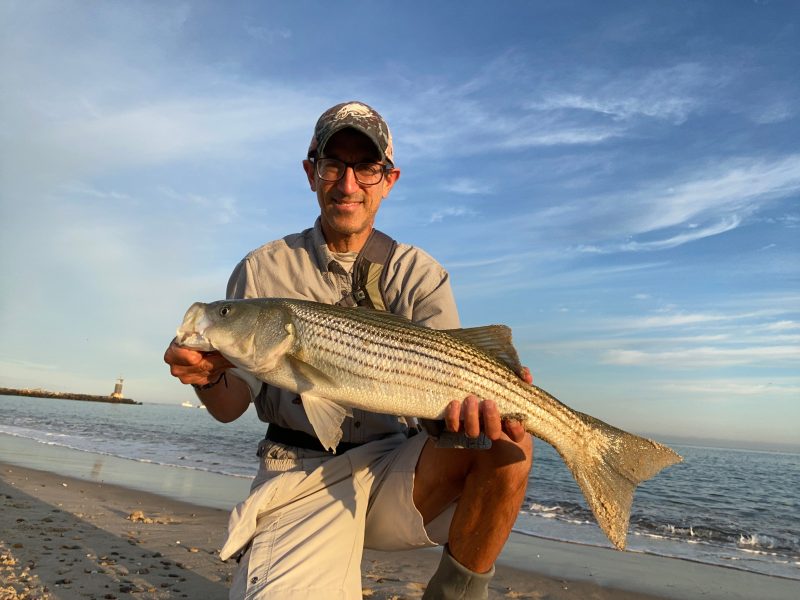
My father had a habit for tailoring iconic quotes from The Godfather to situations in which he found himself. For example, while releasing a fish back from whence it came, Dad often said, “Leave the fish, take the memories” in the accent and cadence of Clemenza telling Rocco to “Leave the gun, take the cannoli.” While my father is long gone and I miss him dearly, his Peter Clemenza impression survives. “Leave the fish, take the memories” echoes almost every time I return a striped bass to the surf or a trout back into a stream. These days, I am predominately a catch-and-release fisherman. I experience as much joy from a tight line as from new sights seen and lessons learned; it is rarely about producing table fare, although I sometimes invite a fish or two home to meet the family with an offer they can’t refuse. At this point in my life, any outing is a success when I hook up with at least one fish or produce some decent fish photography that immortalizes some memory of the day—better yet if I achieve both. When a picture includes a fish destined for release, I make every effort to minimize additional handling and unnecessary time out of the water for my finned friend whose life I dearly want to preserve.
Achieving this goal is often complicated by one of the main attractions of the sport (for me): time spent alone, experiencing nature in its most basic form while disconnecting from the rigmarole and angst of daily life. Even when fishing with mates, the bulk of my actual fishing time is out of earshot or sight line of others. I have experienced the challenges of capturing a quality photo of both angler and fish without leaving both of us with a poor impression of the encounter. I have learned from research that these poor impressions are often mortally costly to one of us.
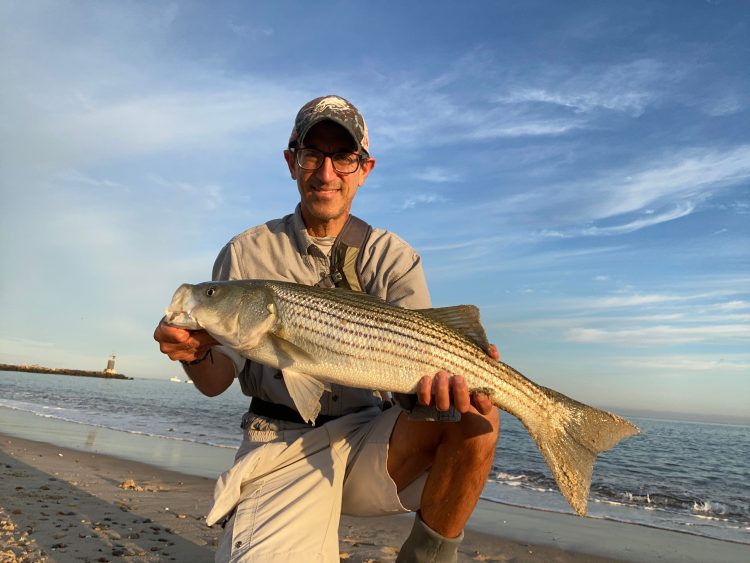
Take the beloved striped bass, for instance. The Atlantic States Marine Fisheries Commission estimates that 9% of the striped bass caught and released alive eventually die because of their interactions with fishermen. According to data collected for the 2019 season, recreational fishermen caught and released 28.8 million striped bass, 2.59 million of which died regardless of being set free. To reduce the mortality rate, anglers should mind the size of their rod, reel, and tackle, limit the “battle-time,” ditch treble hooks, crush barbs, actively man the rod when bait fishing, carefully handle the fish, and minimize time out of the water. The latter two certainly come into play, particularly for those fishing in solitude, when capturing the moment in digital form. This begs the question of how to take good pictures while also taking proper care of our fish. One effective way to facilitate both came to me several years ago.
I was fishing by myself in Island Beach State Park, bouncing a bucktail over sandbars into troughs, when I hooked and landed a 33-inch bass. Quickly freeing its lip from the hook, I held her up for a look-see. She was such a beauty and a pleasant change from the shorts I’d been catching all morning. I heard Dad whisper “Leave the fish, take the memories,” so I holstered my surf rod in my sand spike and took off my day pack. I dug out my phone, awkwardly worked at propping the phone against my pack, set the camera’s time delay to 10 seconds, hit the shutter button, hoisted the fish, and smiled for the camera. Unfortunately, moments before the timer reached zero, the phone toppled over, resulting in nothing more than a blurry picture of beach sand. It took two more attempts, including a trip to the surf to wash sand off the fish, to poorly capture the memory. I did watch it swim away, albeit lethargically. I knew it would have darted swiftly into the surf had it not been for my clumsy photography exploits, and I worried that it would not be long for the ocean. This worry was further driven home by an older fisherman who had apparently been watching from afar. He approached me and said, in a supercilious tone, “Was that picture really worth it?” I said nothing in return since his disdain was deserved, plus I’m fairly sure his query was rhetorical. I realized there must be a better way. The answer would come to me a short while later in a real-life “Hey, You Got Peanut Butter in My Chocolate” Reese’s Peanut Butter Cup moment.
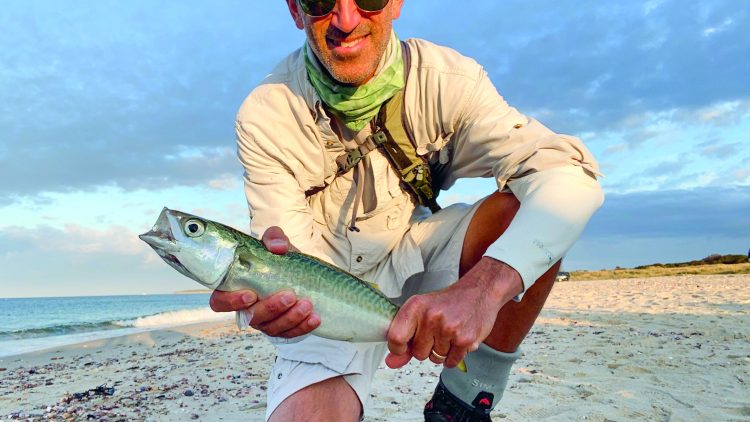
Birth of the Selfie Sand Spike
Back at my car, I leaned my rod against the rear driver-side door, placed my short sand spike against the tire, dropped my plug bag and pack by the hatchback, and peeled myself out of my waders, all while internalizing and weighing the sentiments of my Dad and the old man.
“Leave the fish, take the memories.”
“Was that picture really worth it?”
I was lost in those thoughts as I collected the gear strewn around my car and slammed the hatch shut. While walking toward the driver’s door, I tripped over one piece of gear I had overlooked, my sand spike. I cursed my thoughtlessness, picked it up, and continued to the driver’s seat rather than return to the trunk. After plopping down behind the wheel, I reached over and placed the sand spike on the passenger seat floor, then robotically pulled my mobile phone from my pocket and slapped it onto the magnetic mount holder on the dashboard. I stopped short as I reached to put the key in the ignition because the perfect solution to my picture problem had taken shape in my mind.
Upon returning home, I went online and ordered an additional magnetic dash-mounted phone holder, and two days later, my “selfie sand spike” was born.
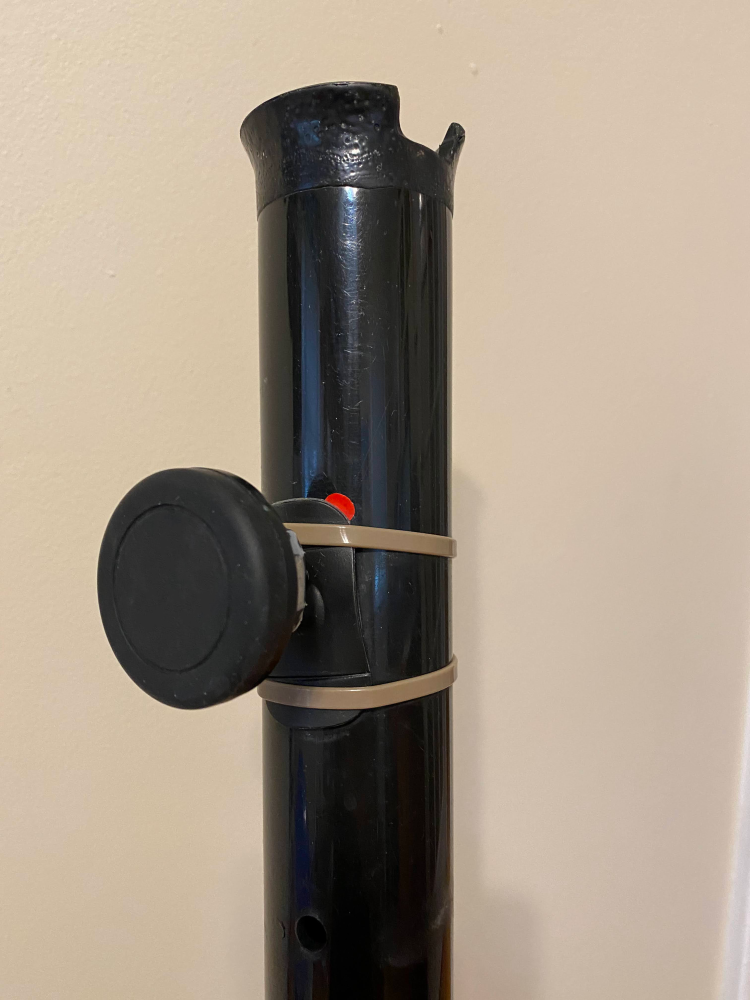
Much like the combination of chocolate and peanut butter was a game-changer in the candy world, the combination of a magnet and a sand spike was a game-changer in my catch, photograph, and release strategy. It also opened an avenue of new opportunities for documenting my fishing pursuits and exploring the great outdoors. It added no more than an ounce in weight to something I already included as part of my surf-fishing kit, and is conveniently attached to a D-ring on my plug bag.
I don’t bring a sand spike for dead-stick fishing, but as a “holster” to stow my rod and reel safely and securely out of the sand. It allows me free hands for tending to other important business such as handling a catch or eating lunch. The magnetic mount cost less than $10 yet has proven a great return on investment.
Magnetic phone-mount kits are ubiquitous, inexpensive, and cleverly designed. They include a mount, which houses the magnet, along with a metal device plate for the back of the phone. To allow arbitrary orientation—portrait, landscape, or something in between—without the phone slipping or completely falling to the ground, the metal plate should be centrally located.
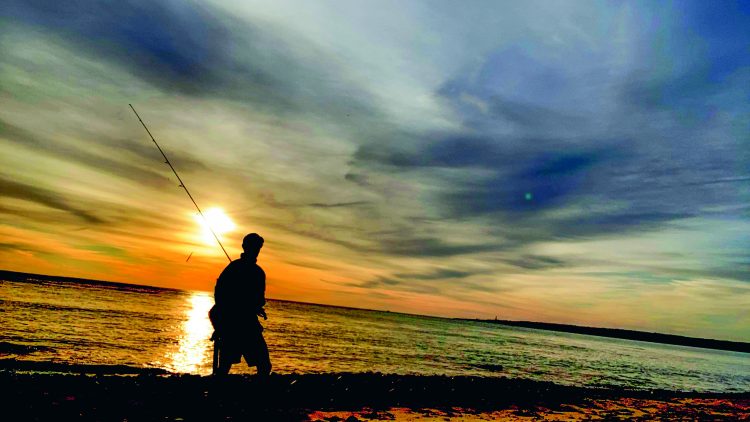
This is convenient for traditional wire-charged phones. Wireless charging relies on an induction coil that is typically located in the phone’s center, so permanently attaching a metal plate there will render the wireless charging system useless. To allow for wireless charging, don’t permanently attach the plate; simply insert it between the phone and its protective case. If you do not already have a protective case, buy one, preferably a version that’s quick to remove. To allow for an additional degree of adjustment, look for a mount incorporating a ball and socket in its design so you can tilt the camera without potentially destabilizing the spike. Most mounts have a self-adhesive backing; however, the harsh surf conditions will rapidly erode the sticking power. In fact, I didn’t even peel back the adhesive’s protective lining. I instead opted to use two 7-inch nylon wire ties to affix the magnetic mount to my spike.
Upon identifying a break in a bar or a deep trough likely to hold fish, I typically unhook my sand spike and stab it into the sand several yards inland of the tidal line on an ebb tide, and roughly twenty yards back on the flood tide. I reposition it every so often in accordance with the shifting tide.
My phone is rated IP68, which means it’s protected against small solids and submersion (“IP” = ingress protection, “6” = impervious to solids as small as dusts, “8” = protected against submersion), so I’m comfortable leaving it attached to the spike while fishing. However, I’m mindful to move things back frequently during the incoming tide as there is no IP rating for the ease of finding a phone buried in the sand or washed out to sea by an errant wave. This eliminates time wasted retrieving my camera when I want to quickly capture a memory and release a fish. Most smartphones today are rated similarly, but if yours is not, don’t leave it on the mount unattended; instead, ensure the phone is easily accessible. When handling a large fish, the phone can be easily attached to the mount using one hand, and once mounted, there is nothing blocking the front or side controls.
Taking the Memory
Besides being able to withstand the elements, my smart phone has a high-quality front-facing camera and a hands-free shutter release. Fortunately, most smart phones today have both. A front-facing camera confirms that you and the fish are in frame when the hands-free shutter release triggers. My phone’s shutter has 3-second and 10-second countdown timers, as well as the ability to trigger with a verbal command. The default shutter release command on my iPhone is “Turn up volume,” and while this can be customized, I’ve never bothered changing it. In addition, I can launch the camera’s front-facing camera app verbally with, “Hey Siri, take a selfie,” so, provided my phone is already magnetically attached to my sand spike, I can take a photo without ever touching the camera or putting the fish down.
There are other means for remotely operating the shutter of your smartphone, such as hand-gesture recognition software and Bluetooth shutter remotes. Unfortunately, these require a third hand, one not readily available to the solo angler simultaneously trying to hold a striped bass by its mouth with one hand and supporting its underbelly with the other. Likewise, there are mobile phone selfie sticks and tripods available. When I’m out in the woods fishing rivers, streams, and lakes, I typically have one in my backpack. However, for times on the beach when I am already lugging around something that can be used instead, I leave them at home.
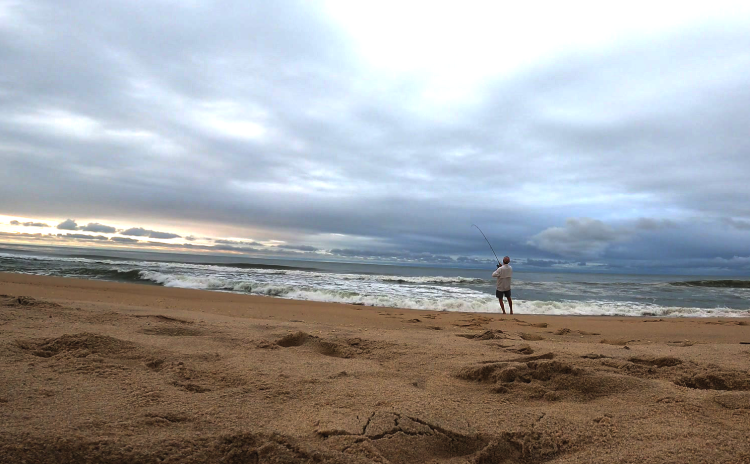
I’ve gotten into the habit of taking quick pictures of most of my catches. While some are well composed and worthy of framing or sharing, that is not often my main motive. Smartphone photos are enriched with GPS coordinates and date/time metadata, technically called EXIF data. I use this information later at home to improve the accuracy of my fishing logs. Incidentally, EXIF data is something to keep in mind when sharing photos. Should you want to maintain the anonymity of your prized secret fishing spots, be sure to remove this data before sharing. The iPhone’s built in Photos application includes the option to remove location data when emailing or instant messaging image files. There are third-party applications for doing this when using other smart phone operating systems.
Even the best of us have days on the water lending support to the saying, “That is why they call it fishing and not catching.” When tight lines are hard to come by, I often leverage my selfie sand spike to capture digital imagery of other aspects of fishing, such as the elegance of a fly cast, the physics of a surf cast, or wonderful visuals stumbled upon while wandering in search of a favorable fishing spot. I often strip the photos in part (or entirely) of color, adjust their contrast and luminescence, and crop out bits I find uninteresting. I think sharing these photos with others is very beneficial to the sport since I often field interesting questions which, in turn, result in others getting educated and excited about the pursuit of such a wonderful pastime.
1 thought on “Take Better Fish Selfies”
-
Raymond Ross Great Article, I learned a lot. now to try it for myself. Thanks.
Leave a Reply